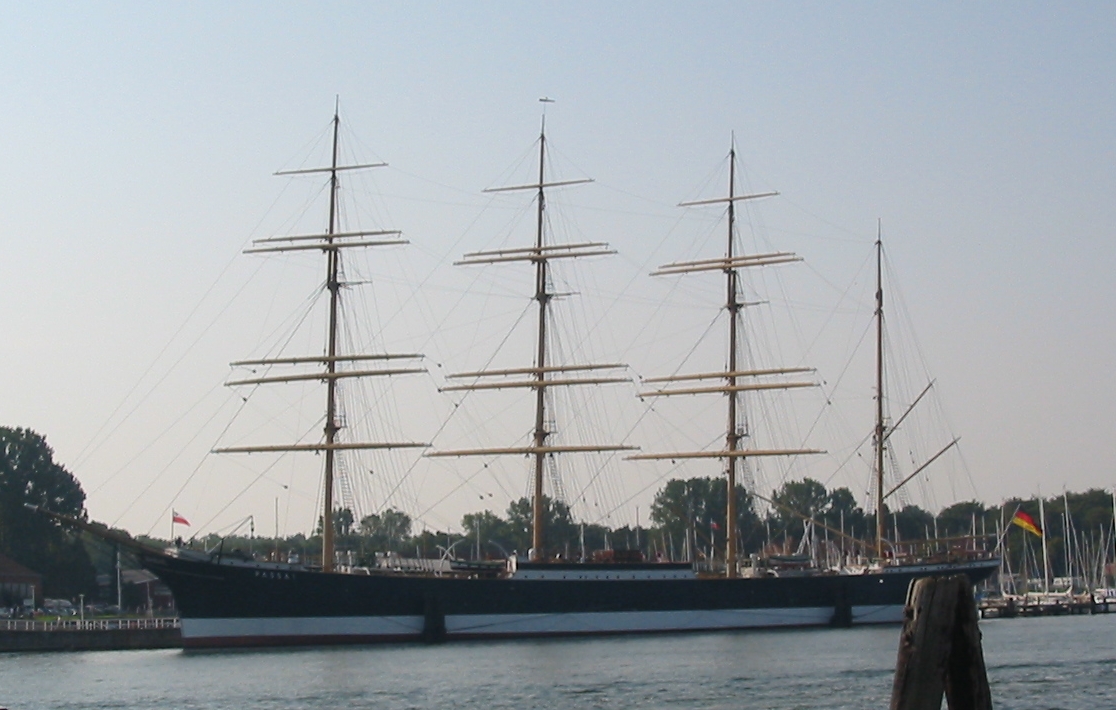|
Priwall Peninsula
The Priwall Peninsula (German: ''die Halbinsel Priwall'' or'' Der Priwall'') is a spit located across from the town of Travemünde at the Trave River estuary, on Germany's Baltic Sea coast. Since 1226 it has been administratively part of Travemünde, itself controlled by Lübeck. The southern part has been designated a nature reserve (''Naturschutzgebiet Südlicher Priwall''). The Priwall is the eastern terminus of a bicycle path, opened in 1995, that begins at the Danish border at the town of Kruså. More famously, it is the northern terminus of the former inner German border, and a few remnants of the border fortifications have been preserved near the beach. The Priwall's principal attraction is otherwise the four-masted barque ''Passat'' (now a museum ship) of the Flying P Line – which also included the four-masted barque '' Priwall''. The beaches of the Priwall at the Bay of Lübeck were the site of a former annual sand festival called Sand World. See also * German lang ... [...More Info...] [...Related Items...] OR: [Wikipedia] [Google] [Baidu] |
Spit (landform)
A spit or sandspit is a deposition bar or beach landform off coasts or lake shores. It develops in places where re-entrance occurs, such as at a cove's headlands, by the process of longshore drift by longshore currents. The drift occurs due to waves meeting the beach at an oblique angle, moving sediment down the beach in a zigzag pattern. This is complemented by longshore currents, which further transport sediment through the water alongside the beach. These currents are caused by the same waves that cause the drift. Hydrology and geology Where the direction of the shore inland ''re-enters'', or changes direction, for example at a headland, the longshore current spreads out or dissipates. No longer able to carry the full load, much of the sediment is dropped. This is called deposition. This submerged bar of sediment allows longshore drift or littoral drift to continue to transport sediment in the direction the waves are breaking, forming an above-water spit. Without the co ... [...More Info...] [...Related Items...] OR: [Wikipedia] [Google] [Baidu] |
Barque
A barque, barc, or bark is a type of sailing ship, sailing vessel with three or more mast (sailing), masts having the fore- and mainmasts Square rig, rigged square and only the mizzen (the aftmost mast) Fore-and-aft rig, rigged fore and aft. Sometimes, the mizzen is only partly fore-and-aft rigged, bearing a square-rigged sail above. Etymology The word "barque" entered English via the French term, which in turn came from the Latin language, Latin ''barca'' by way of Occitan language, Occitan, Catalan language, Catalan, Spanish, or Italian. The Latin ''barca'' may stem from Celtic language, Celtic ''barc'' (per Rudolf Thurneysen, Thurneysen) or Greek ''baris'' (per Friedrich Christian Diez, Diez), a term for an Egyptian boat. The ''Oxford English Dictionary'', however, considers the latter improbable. The word ''barc'' appears to have come from Celtic languages. The form adopted by English, perhaps from Irish language, Irish, was "bark", while that adopted by Latin as ''barca ... [...More Info...] [...Related Items...] OR: [Wikipedia] [Google] [Baidu] |
Lübeck
Lübeck (; Low German also ), officially the Hanseatic City of Lübeck (german: Hansestadt Lübeck), is a city in Northern Germany. With around 217,000 inhabitants, Lübeck is the second-largest city on the German Baltic coast and in the state of Schleswig-Holstein, after its capital of Kiel, and is the 35th-largest city in Germany. The city lies in Holstein, northeast of Hamburg, on the mouth of the River Trave, which flows into the Bay of Lübeck in the borough of Travemünde, and on the Trave's tributary Wakenitz. The city is part of the Hamburg Metropolitan Region, and is the southwesternmost city on the Baltic, as well as the closest point of access to the Baltic from Hamburg. The port of Lübeck is the second-largest German Baltic port after the port of Rostock. The city lies in the Northern Low Saxon dialect area of Low German. Lübeck is famous for having been the cradle and the ''de facto'' capital of the Hanseatic League. Its city centre is Germany's most extens ... [...More Info...] [...Related Items...] OR: [Wikipedia] [Google] [Baidu] |
Peninsulas Of Schleswig-Holstein
A peninsula (; ) is a landform that extends from a mainland and is surrounded by water on most, but not all of its borders. A peninsula is also sometimes defined as a piece of land bordered by water on three of its sides. Peninsulas exist on all continents. The size of a peninsula can range from tiny to very large. The largest peninsula in the world is the Arabian Peninsula. Peninsulas form due to a variety of causes. Etymology Peninsula derives , which is translated as 'peninsula'. itself was derived , or together, 'almost an island'. The word entered English in the 16th century. Definitions A peninsula is usually defined as a piece of land surrounded on most, but not all sides, but is sometimes instead defined as a piece of land bordered by water on three of its sides. A peninsula may be bordered by more than one body of water, and the body of water does not have to be an ocean or a sea. A piece of land on a very tight river bend or one between two rivers is sometimes ... [...More Info...] [...Related Items...] OR: [Wikipedia] [Google] [Baidu] |
Luftwaffe
The ''Luftwaffe'' () was the aerial-warfare branch of the German ''Wehrmacht'' before and during World War II. Germany's military air arms during World War I, the ''Luftstreitkräfte'' of the Imperial Army and the '' Marine-Fliegerabteilung'' of the Imperial Navy, had been disbanded in May 1920 in accordance with the terms of the 1919 Treaty of Versailles which banned Germany from having any air force. During the interwar period, German pilots were trained secretly in violation of the treaty at Lipetsk Air Base in the Soviet Union. With the rise of the Nazi Party and the repudiation of the Versailles Treaty, the ''Luftwaffe''s existence was publicly acknowledged on 26 February 1935, just over two weeks before open defiance of the Versailles Treaty through German rearmament and conscription would be announced on 16 March. The Condor Legion, a ''Luftwaffe'' detachment sent to aid Nationalist forces in the Spanish Civil War, provided the force with a valuable testing grou ... [...More Info...] [...Related Items...] OR: [Wikipedia] [Google] [Baidu] |
Sand Festival
Sand festivals or festivals of sand sculpture are exhibitions of sculptures made of sand carried out in various places around the world. These events usually include a competition. Traditional sand sculptures are sandcastles. However, at sand festivals one may see virtually any kinds of sculptures you would expect to see in stone, bronze or wood. Australia The ''Sand Sculpting Australia'' festival has been held annually in Frankston, Victoria since 2008, and was held for seven years prior to this on the foreshore at Rye, Victoria. This event features a different theme each year, with the 2008–2009 theme being dinosaurs in an exhibit called "Dinostory". Canada *Clam Harbour, Nova Scotia *Lac Beauchamp Park *Harrison Hot Springs, British Columbia Former Host of the World Championships of sand sculpture. Fort Myers Beach Florida, is the host of the Solo Division in 2011. Siesta key, Florida will host the Doubles Division. Germany Germany conducts regular sand festivals ... [...More Info...] [...Related Items...] OR: [Wikipedia] [Google] [Baidu] |
Bay Of Lübeck
The Bay of Lübeck (, ) is a basin in the southwestern Baltic Sea, off the shores of German states of Mecklenburg-Vorpommern and Schleswig-Holstein. It forms the southwestern part of the Bay of Mecklenburg. The main port is Travemünde, a borough of the city of Lübeck, at the mouth of river Trave. The Elbe–Lübeck Canal connects the Baltic Sea with the Elbe River. The bay is surrounded by the landstrips of Ostholstein and Nordwestmecklenburg. Located in the North of the Bay, the Hansa-Park amusement park creates a popular sight for families all around the region and Southern Denmark. The Pötenitzer Wiek lake splits the states of Schleswig-Holstein and Mecklenburg-Vorpommern and got historical attention, as it gave East Germany refugees the possibility to flee from East Germany in to West Germany. Gallery File:Lübecker Bucht, Seegebiet.jpg, File:Blick auf Nordermole und Lübecker Bucht.JPG File:Lübecker Bucht vom Hansapark aus gesehen - panoramio.jpg File:Lübecker Buc ... [...More Info...] [...Related Items...] OR: [Wikipedia] [Google] [Baidu] |
Priwall (barque)
''Priwall'' was a four-masted steel-hulled barque with royal sails over double top and topgallant sails. The windjammer was ordered by the F. Laeisz shipping company of Hamburg and launched at the Blohm & Voss yard, Hamburg, on 23 June 1917. After delays arising from a shortage of materials during and after First World War, she was completed on 6 March 1920. ''Priwall'' was used on the nitrate trade route to the west coast of South America; she also made several voyages from South Australia’s Spencer Gulf grain ports to Europe. Her code Letters were RWLN; in 1934 they were changed to DIRQ. History and performance While still at the builders, ''Priwall'' (with other German merchant vessels) was identified in 1919 for confiscation by the Allies as World War I reparations. However, due to the incomplete state of the ship, delivery to the Allies was not enforced and thus allowed the Laeisz company to finish construction – and, after outfitting, to operate the ship as intende ... [...More Info...] [...Related Items...] OR: [Wikipedia] [Google] [Baidu] |
Flying P Line
The Flying P-Liners were the sailing ships of the German shipping company F. Laeisz of Hamburg. History The company was founded in 1824 by Ferdinand Laeisz as a hat manufacturing company. He was quite successful and distributed his hats even in South America. In 1839, he had the three-masted wooden brig ''Carl'' (named after his son) built and entered the shipping business, but lack of success made him sell the ship a short five years later. Ferdinand's son Carl Laeisz entered the business in 1852. It was he who turned the F. Laeisz company into a shipping business. In 1857, they ordered a barque which they named ''Pudel'' (which was the nickname of Carl's wife Sophie), and from the mid-1880s on, all their ships had names starting with "P" and they became known as "the P-line". The last ship without a "P-name" was the wooden barque ''Henriette Behn'' which was stranded on the Mexican coast in 1885. The Laeisz company specialized in the South American nitrate trade. Their ... [...More Info...] [...Related Items...] OR: [Wikipedia] [Google] [Baidu] |
Museum Ship
A museum ship, also called a memorial ship, is a ship that has been preserved and converted into a museum open to the public for educational or memorial purposes. Some are also used for training and recruitment purposes, mostly for the small number of museum ships that are still operational and thus capable of regular movement. Several hundred museum ships are kept around the world, with around 175 of them organised in the Historic Naval Ships AssociationAbout The Historic Naval Ships Association (the international website. Accessed 2008-06-06.) though many are not naval museum ships, from general merchant ships to [...More Info...] [...Related Items...] OR: [Wikipedia] [Google] [Baidu] |




